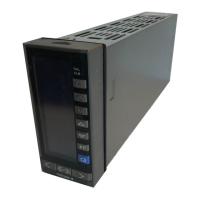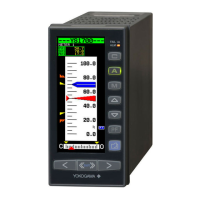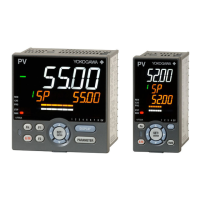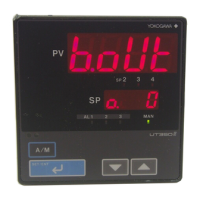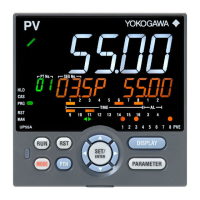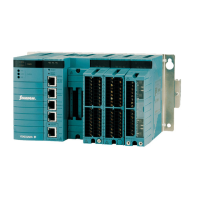41
IM 01B08B02-01EN
Tuning Guide
Tuning Guide
PID Parameter Tuning Guide and Automatic Adjustment
If the indicating controller is used for an unknown process, it is important to examine the conditions carefully in which the controller is
operated by manual adjustment because they are useful in determining the proportional band (PBn), integral time (Tn), and derivative
time (TDn) when entering automatic adjustment. (n = 1, 2)
For example, if the process variable (PV) changes significantly when the controller’s manipulated output variable (MV) is simply
changed slightly, the proportional band (PBn) needs to be widened as a safety provision. In a case where the opposite conditions
prevail, the proportional band needs to be narrowed.
Moreover, for processes wherein the time required to follow a change in the controller’s output is short, the integral time and
derivative time must also be made short. For processes in which recovery time is long, these times need to be made longer.
(1) “Proportional + integral” controllers
1. Set the operation mode to manual control (M mode) and
match the process variable with the setpoint by manual oper-
ation. Set the integral time to 9999 seconds, the proportional
band to a sufficiently large value, and the derivative time to 0
seconds.
2. Change the operation mode to automatic control (A mode).
3. Conduct the following operations to obtain the optimum value
for the proportional band.
• Lower the proportional band from a sufficiently large value
to a smaller value (for example, from 100% to 50% to
20%). In this case, provide sufficient time to observe the
control conditions at each stage. Continue this process until the control loop’s continuation vibration (cycling) starts.
Then measure the proportional band value (PBu) and cycling interval (Pu) at this point.
(Cycling is a phenomenon caused because the proportional band has been made narrower than the process’s maxi-
mum value. It can be identified by the fact that the process variable indication regularly vibrates centering around the
point set.) A value approximately 2.2 times the proportional band at which cycling occurs is the maximum proportional
band (2.2 PBu).
• Next, the cycling period is measured. A value about 0.83
times the vibration cycle is the integral time to be obtained
(0.83 Pu). In general, even if the integral time is significantly
reduced, the time taken to balance to the setpoint merely
becomes shorter, not changing the operation conditions
significantly. However, if it is lowered below a certain critical
value determined by the process’s delay characteristics,
cycling occurs after all. This is due to the integral time hav-
ing been lowered too excessively. In this case, increase the
integral time gradually until cycling stops.
(2) “Proportional + integral + derivative” controllers
1. Set the operation mode to manual control (M mode) and match a process variable with the setpoint by manual operation.
Set the integral time to 9999 seconds, the proportional band to a sufficiently large value, and the derivative time to 0 sec-
onds.
2. Change the operation mode to automatic control (A mode).
3. Change the proportional band as outlined in the case of the “proportional + integral” controllers in item (1) to look for the
point at which cycling just starts to occur. Measure the proportional band (PBu) value and the cycling period (Pu) at this
point.
4. The optimum setpoints are determined as follows:
Proportional band = 1.7 PBu
Integral time: 0.5 Pu
Derivative time: 0.125 Pu
The method described above is known as the Ziegler Nichols limitation sensitivity method, which allows response characteristics
to be obtained in which vibration attenuation is about 25%. Apart from this, various adjustment methods have been proposed,
including the step response method shown below. Refer to the technical books of automatic control as necessary.
In auto-tuning (AT)
ON/OFF control
PID control based on
PID constants obtained
as a result of AT
Process variable
ON
OFF
0806E.ai
Time
Setpoint
Manipulated
output variable
0804E.ai
For a small proportional band
Target
setpoint
* If the proportional band is small, the PV becomes vibrational.
Offset
Time
For a larger proportional band
For an intermediate proportional band
Temperature
0805E.ai
Target
setpoint
* If the integral time is too short,
long cyclic vibration occurs in the PV.
Time
Temperature
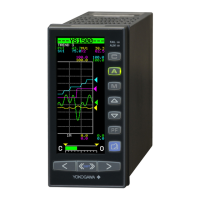
